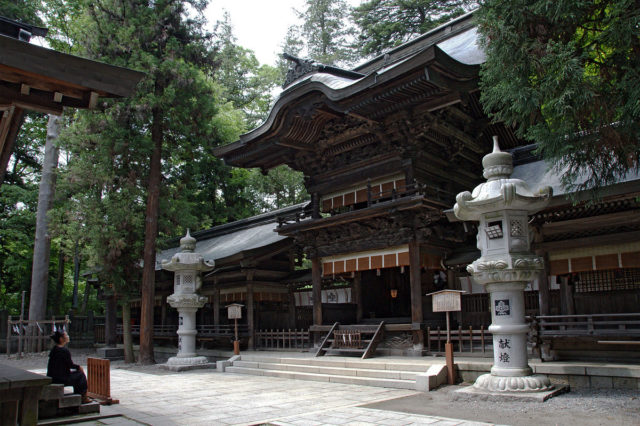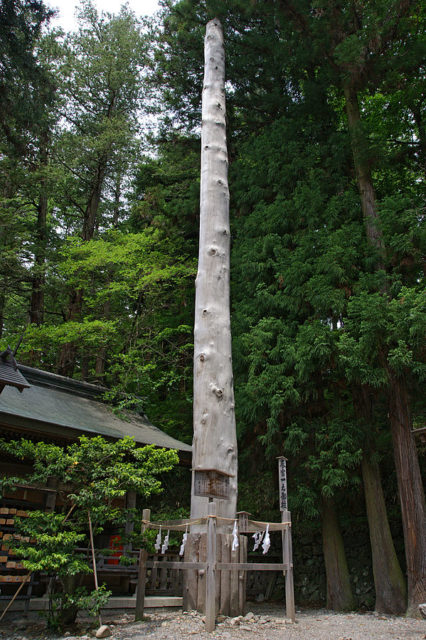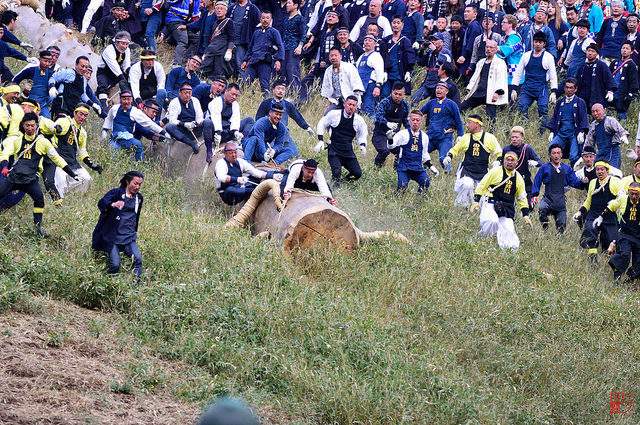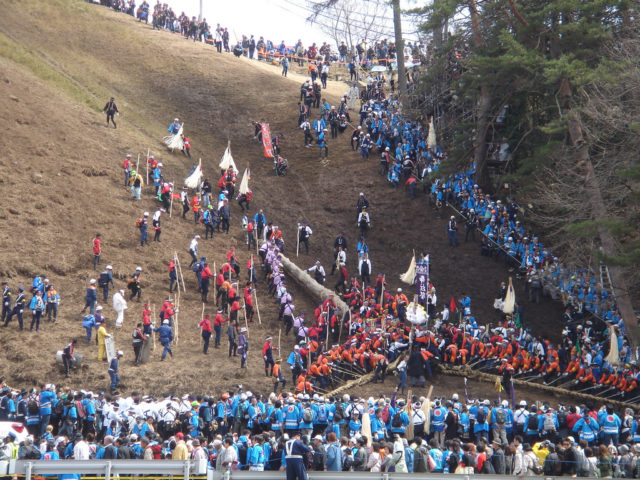Celebrated for more than 12 centuries, Suwa’s Onbashira Festival occurs only once every six years, in the years of the Monkey and the Tiger, according to the Chinese zodiac. Alternative sources suggest the processions are held every seventh year, due to the Japanese custom of counting time differently. However, the last time it took place was in 2016, and the next one is likely to take place in 2022.
This very old festival tradition involves replacing sacred pillars at the four shrines, two Upper and two Lower, of Suwa-Taisha, Suwa’s Grand Shrine. The site can be found northwest of Tokyo in the Lake Suwa area of the Japanese Nagano Prefecture.

Hands-on activities are largely highlighted throughout the processions, as participants conduct the pillar replacement project by themselves. Locals spend a lot of time in preparation, and it all begins once 16 gigantic fir trees have been selected and cut down in the woods. There are also some pretty dangerous parts within the processions, such as moving the logs through rivers or riding them down through some pretty steep hills. Once the logs reach the shrine, the pillars are raised with participants clinging on tightly and celebrating. It indeed looks like a great spectacle, but at moments, also a terrifying one.
The Onbashira Festival aims to symbolically renew the four shrine buildings, so 16 fir trees in total are used. The cut trees are consequently prepared as honored pillars, i.e. “onbashira,” thus the name of the festival.

The Onbashira festival occurs in the time span of a few months and the main processions are split into two parts: Yamadashi and Satobiki. The first traditionally takes place in the month of April, and the second in May.
Yamadashi literally stands for “coming out of the mountains” and it is in this part when the 16 trees, each up to 62 feet tall, are prepared through a Shinto ceremony.
The Shinto, also known as “kami-no-machi,” is an ancient Japanese religion that worships the ancestors and nature spirits. The traditional Shinto followers take care to carry out all related Shinto processions diligently, and that is no different in the case of the Onbashira festival. Everything is indeed prepared carefully, with the means to establish a connection between modern-day Japan and the ancient past of the Far Eastern country.

Consequently, specially made axes and adzes are used for the trees. After that, the logs are decorated in red and white regalia, the two traditional colors of Shinto ceremonies. Ropes are also attached to the trees to help the dragging from the woods to the shrines.
The course of the logs always progresses through some rough terrain, and at certain points, participants also must drop the logs down steep slopes. Young men use the occasion to demonstrate their bravery by riding the logs, which can sometimes weigh as much as 12 tons. This part of the ceremony is known as Kiotoshi, which translates as “tree falling.”

The second part of the festivities, known as Satobiki, are scheduled for a month later. In a colorful parade, the logs are moved towards the shrine buildings where they are to be positioned: Honmiya, Maemiya, Harumiya, and Akimiya. Four “onbashira” are erected at each building, one sacred pillar being placed at each corner. The logs are raised with ropes and by hand. Other groups also sing and perform at the venue.
The entire festival is concluded with a follow-up event, called “Building of Hoden.” However, the closure of the festival is nowhere near as famous as Yamadashi and Satobiki.

The Onbashira festival has gained a reputation for being probably the most dangerous festival in Japan. Casualties are reported frequently during the processions take place, including severe injuries and sometimes fatalities among participants.
Every 6 years, thousands of people in the Suwa area of Japan celebrate the Onbashira festival. Learn more here: https://t.co/vYEsxSoHj0 pic.twitter.com/m1eMz04cWW
— NatGeoTravel (@NatGeoTravel) May 25, 2017
In 1994, two men were unfortunately drowned while attempting to pull the log across a river within their group. Two men had also died in 2010 after falling from a 33 foot tall tree that was being raised at the Suwa Grand Shrine. Two more individuals were injured in the same accident. In 2016, one man died falling from a tree that was being raised at the shrine, too.
Nevertheless, with each passing edition of Onbashira, the festivities gain momentum and interest not only among local people but wider audiences across Japan and beyond. Somewhat less crowded adaptations of the spring festivities, known as “komiya no Onbashira” are known to be held in smaller communities across the Suwa region, during the late summer periods. Enthusiasts often look for the opportunity to join the activities and be part of the pillar construction crew during these downsized versions of Onbashira.The processions also gained momentum after being part of the opening ceremonies of the 1998 Winter Olympics in Nagano.
